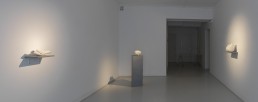Gallery Ama | Helsinki | 2020
Kaisaleena Halinen: Sinelmä/Bruise 9.10.-1.11.2020
STRONG WORKS ABOUT FRAGILITY
Kaisaleena Halinen has described the strong influence that a past incident has had on the works of the current exhibition. During the Summer Exhibition of 2019 in Riihimäki, somebody broke into the exhibition hall and demolished many of the works. A ceramic bust of a little girl had been shattered by a blow on the forehead. The artist only realized the violence and the weight of the act later when she was repairing the bust. Halinen decided to change her plans for the upcoming exhibition and put aside the works she had already started to work with. It felt more meaningful to let out the ideas that had started to emerge due to this broken and repaired bust.
The art of Kaisaleena Halinen is delicate and fragile, but it arouses strong, intimate sensations. In the current exhibition in Galleria Ama, Halinen continues with her deep, profound reflection on humanity, power, violence, fragility and shame. Changes in the fragile surface of the delicate ceramic sculptures evoke, through connotations, strong and almost physical sentiments.
In a video work called Sinelmä/Bruise, a reddish patch resembling a bruise starts to emerge in a cheek of ceramic head of a woman. In a viewer’s mind, it conjures up images of domestic violence, oppression and control over others. When the patch spreads, you start to notice cracks, net-like craquelures, on the ceramic surface. The paradoxical beauty of the hairline fractures reinforce the sense of threat and malice.
Halinen uses these fractured surfaces, produced by a matt white craquelé glaze, as an effect also in many other works of this exhibition. The closed eyelids of the piece called Näkijä/Seer are covered with a network of hairline fractures. The lips of the adjacent heads in Requiem are cracked. Human life and human relationships are brittle, fragile and shattered. The ceramic heads become associated with death masks. The surface of some of the sculptures is treated in part with ink, that makes the hairline fractures stand out. This conjures up an image of a subcutaneous, self-determining and otherwise invisible energy.
Halinen has examined the ways ceramics behave, for example, by filling a hollow cast head with water (Waves), and by soaking ceramic feet in water containing ink and coffee (Herkistyminen/Sensitization). The feet absorb water and darken. These changes Halinen has recorded in her videos. In the gallery, the three videos are projected each on their own wall. The realistic effect is increased by the fact that the objects are life-size: the feet are the size of human feet, the head is the size of a human head. The impression of blushing in a piece called Waves has been achieved by first adding a small amount of red pigment to the casting slip. When the burnt sculpture gets wet, it turns darker and ”blushes”. The hollow sculpture has been filled with water when upside down, so blushing seems to rise from the inside.
In the video piece Sinelmä/Bruise, where a bruise emerges on a woman’s face, it starts as red and very small but expands and turns bluish. Some inks can penetrate a ceramic surface and colour it. The ceramic material lets through the red colour in the ink first, and after that, the blue.
In a small back room of the gallery, there is a torso of a man lying on a low pedestal. A video of a stone being thrown through thin ice is projected on the torso. The ice appears to form a skin on the torso, which is then broken by the stone. From under the ice, water wells up like blood or some other bodily fluid. The sound of the breaking ice accentuates a feeling of pain and agony.
In the field of art in Finland, there is a lively debate going on about the meaning of art and its purpose. Should art be used for making a statement or should it keep to its own values? In a critics’ journal, Kritiikin uutiset, Olli Ahlroos writes about experiencing art and being touched by art. He says: ”Experiencing art is a rare and improbable event that takes place in the presence of exceptional works of art.”
Ahlroos is referring to the thinking of Gilles Deleuze, for whom great art is political. For Deleuze the political nature of art does not depend on the artist’s political views but it is a question of quality. ”A great work of art is political, because, according to Deleuze, that is what an act of creating by definition is. An artist should create, not ‘reflect’ reality or convey reactive ‘information’”. Creating something new is political, because it forces something unprecedented and uncontrollable on the surface of an artwork, on its structures and on the surrounding reality. A creative act opens, by way of the surface of the artwork and through it, a possibility to experience something, that the existing political parties and ideologies cannot bring under control in their system. Only creating something uncontrollable is ”an act of resistance” according to Deleuze.”[1]
Experiencing art is a rare and improbable event that takes place in the presence of exceptional works of art. This kind of event can be experienced looking at the works of Kaisaleena Halinen.
Marja Sakari
PhD, Director of Ateneum Art Museum
——
[1] https://www.kritiikinuutiset.fi/2019/12/15/kasittamaton-taide-osa-2-luomistekojen-etiikasta/?fbclid=IwAR1Q_u1AvKol4jPwYmD8FxKI0KTJrFgUey9MyF2mCYu4OL_ekHB4eCah1fw





